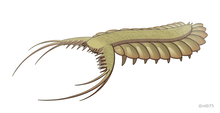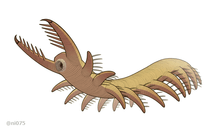Omnidens
Omnidens amplus, meaning "large all-tooth", is an extinct species of large Cambrian animal known only from a series of large mouth apparatus, originally mistaken as the mouthparts of anomalocaridids.[1] When first named, it was interpreted as a giant priapulid, but is now considered a panarthropod. Its mouth apparatus closely resembles that of the smaller gilled lobopodian Pambdelurion, indicating it is likely to have been a close relative of that species, with which it may be synonymous.[2] With a maximum estimated body length of 1.5 metres (4.9 ft), Omnidens is the largest known free-living Cambrian organism.[2] Omnidens fossils are found in the Maotianshan Shales.[1]
| Omnidens | |
|---|---|
| Scientific classification | |
| Kingdom: | Animalia |
| (unranked): | Panarthropoda |
| Genus: | †Omnidens Hou, Bergström, and Yang, 2006 |
| Type species | |
| Omnidens amplus Hou, Bergström, and Yang, 2006 | |
Description


Omnidens is only known from mouthparts. The preserved mouthparts would have formed a short muscular, potentially protrusible pharynx surrounded by circles of spiny sclerites, which were reminiscent of the scalids of priapulids, kinorhynchs, and loriciferans. The inside of the pharynx was also lined with several rows of pharyngeal sclerites. Based on the large size of its preserved mouthparts, Omnidens is estimated to have reached a length of up to 1.5 metres (4.9 ft).[2] Its overall appearance was likely similar to that of its close relative Pambdelurion. Spines preserved near the mouthparts of Omnidens may belong to frontal appendages like those of other stem-group arthropods.
Classification
| |||||||||||||||||||||||||||||||||||||||||||||||||||
| Phylogenetic relationships of Panarthropoda,[3] with possible bearers of the Omnidens mouthparts bolded |
Omnidens is classified as a stem-group arthropod.[2] It is so similar to Pambdelurion that the two taxa may be synonymous, but no Pambdelurion specimens are known from the same strata as Omnidens. It is possible that Omnidens mouthparts belong to the contemporary lobopodians Megadictyon or Jianshanopodia.
Distribution
Omnidens is a member of the Chengjiang Biota of China,[1] which dates to approximately 520 Ma, during Cambrian Stage 3.[4] Omnidens-like mouthparts have also been found in the slightly younger Xiaoshiba Lagerstätte.[5] Pambdelurion, which has mouthparts nearly identical to those of Omnidens, is from the Sirius Passet Lagerstätte of Greenland.[2]
History
The first-described specimen of Omnidens was first described in 1994. At the time, it was interpreted as the oral cone of an anomalocaridid, and it was used as evidence to claim that anomalocaridids could reach a maximum body length of up to 2 meters (6.6 ft).[6] Omnidens fossils were later described as specimens of Peytoia and Parapeytoia until finally being recognized as a distinct species in 2006 and named Omnidens amplus.[1] At this time, it was reinterpreted as a gigantic priapulid, at least 1 metre (3.3 ft) long, far exceeding most known priapulids in size. Omnidens was later identified as a close relative of the gilled lobopodian Pambdelurion.[2]
References
- Hou, Xianguang; Bergström, Jan; Jie, Yang (2006). "Distinguishing anomalocaridids from arthropods and priapulids". Geological Journal. 41 (3–4): 259–269. doi:10.1002/gj.1050.
- Vinther, Jakob; Porras, Luis; Young, Fletcher J.; Budd, Graham E.; Edgecombe, Gregory D. (2016). "The mouth apparatus of the Cambrian gilled lobopodian Pambdelurion whittingtoni". Palaeontology. 59 (6): 841–849. doi:10.1111/pala.12256. ISSN 1475-4983.
- Howard, Richard J.; Hou, Xianguang; Edgecombe, Gregory D.; Salge, Tobias; Shi, Xiaomei; Ma, Xiaoya (2020). "A Tube-Dwelling Early Cambrian Lobopodian". Current Biology. doi:10.1016/j.cub.2020.01.075. ISSN 0960-9822.
- Hofmann, M. H.; Li, X. H.; Chen, J.; MacKenzie, L. A.; Hinman, N. W. (2016). "Provenance and temporal constraints of the Early Cambrian Maotianshan Shale, Yunnan Province, China". Gondwana Research. 37: 348–361. doi:10.1016/j.gr.2015.08.015.
- Li, Wei; Yang, Jie; Zhang, Xiguang (2018). 寒武系第3阶小石坝化石库Omnidens-like口器研究. 中国古生物学会第十二次全国会员代表大会暨第29届学术年会论文摘要集.
- Chen, Jun-Yuan; Ramskold, Lars; Zhou, Gui-Qing (1994). "Evidence for Monophyly and Arthropod Affinity of Cambrian Giant Predators". Science. 264 (5163): 1304–1308. doi:10.1126/science.264.5163.1304.